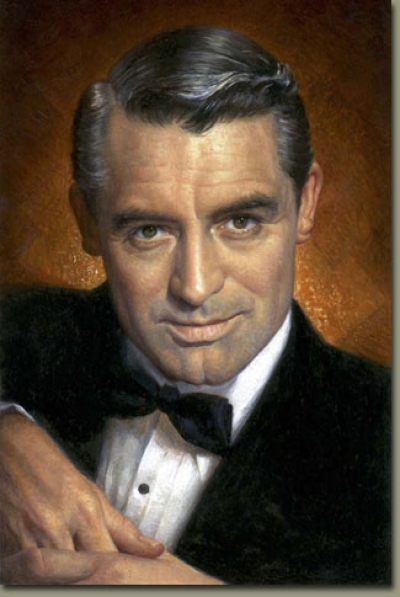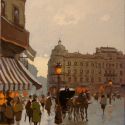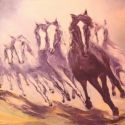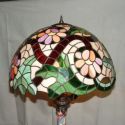
photo: http://www.michaeldeas.com/Mike%20Deas%20Website/site_images/Cary_Grant_High.jpg
Biography
Archibald Alexander Leach (January 18, 1904 – November 29, 1986), better known by his screen name, Cary Grant, was a British-born American film actor. He was perhaps the foremost exemplar of the debonair leading man, not only handsome, but witty and charming.
Contents
1 Early life and career
2 Hollywood stardom
3 Personal life in Hollywood
4 Legacy
5 Quotations
6 Trivia
7 Filmography
8 Footnote
9 External links
10 Outside Reading
Early life and career
Archie Leach was born in Horfield, Bristol, England. He was an only child and had a confused and unhappy childhood. His mother, Elsie, was placed in a mental institution when Archie was only nine. His father never told him the truth, and he only learned twenty years later that his mother was still alive.
This left Leach/Grant with an insecurity in his relations with women and a secretiveness about his inner life that may explain the outward displays of bravado and charm that characterize most of his screen performances, in films as different as The Philadelphia Story and Notorious.
Grant's unhappy childhood, by his own account, led him to crave applause and attention and to create a new persona that would attract it. After being expelled from Fairfield School in Bristol in 1918 for an incident involving the girls' bathroom, he joined the Bob Pender stage troupe. Grant traveled with the troupe to the United States in 1920 for a two year tour; when the troupe returned to Britain, Grant stayed in the States. There, he created over time a unique accent and persona that mixed working and upper class accents, while supporting himself as, among other things, a hawker.
Hollywood stardom
After some success in light Broadway comedies, he came to Hollywood in 1931, where he acquired the name Cary Grant.
Grant starred in some of the classic screwball comedies, including The Awful Truth with Irene Dunne, Bringing Up Baby with Katharine Hepburn, His Girl Friday with Rosalind Russell and Arsenic and Old Lace with Priscilla Lane. These performances solidified his appeal, and The Philadelphia Story, with Hepburn, established his best-known screen role: the charming if sometimes unreliable man, formerly married to an intelligent and strong-willed woman who first divorced him, then realized that he was — with all his faults — irresistible. Grant subsequently took that character in a far darker direction in Suspicion, directed by Hitchcock, without losing his charm or his audience's devotion.
Grant was one of Hollywood's top box-office attractions for several decades. He was a versatile actor, who did demanding physical comedy in movies like Gunga Din with the skills he had learned on the stage. Hitchcock, who was notorious for disliking actors, was very fond of Grant, saying that Grant was "the only actor I ever loved in my whole life". Howard Hawks was just as devoted, saying that Grant was "so far the best that there is. There isn't anybody to be compared to him".
In the mid-1950s, Grant formed his own production company, Grantley Productions, and via a distribution deal with Universal produced what many consider some of his finest work, including Operation Petticoat, Indiscreet, That Touch Of Mink (co-starring Doris Day), and Father Goose.
Grant was a favorite actor of Alfred Hitchcock, appearing in his films Suspicion, Notorious, To Catch a Thief (with Grace Kelly) and North by Northwest (with Eva Marie Saint). The latter was Grant's most successful movie; he plays an advertising agent who gets mistaken for a spy in a classic story of an average person caught up in situations beyond his or her control.
Grant aged extremely well; many fans believe that he got more handsome with age, as his hair went from dark to a salt and pepper colour that added to his dignified appearance.
Politically, Grant was a Republican, and he introduced First Lady Betty Ford to the audience at the Republican National Convention in 1976.
Although twice nominated for an Academy Award, he never won but was honored in 1970 with a special Academy Award for Lifetime Achievement. In 1981, he received the Kennedy Center Honors.
In the last few years of his life, Grant undertook tours of the United States with his "A Conversation with Cary Grant", in which he would show clips from his films and afterward hold a question-and-answer session with the audience. It was just before one of these performances, in Davenport, Iowa, that Grant suffered a severe stroke (November 29, 1986), and died in the hospital a few hours later at the age of 82.
Personal life in Hollywood
Grant's personal life was complicated, involving five marriages and speculation about his sexuality.
In 1932 he met fellow actor Randolph Scott on the set of Hot Saturday, and the two developed a close friendship, sharing a rented house for twelve years. The beach house they shared was known as "Bachelor Hall" and was frequently visited by women guests. However, rumors ran rampant at the time that Grant and Scott were actually lovers and that the name "Bachelor Hall" was invented by the studio to shield their two major stars from scandal. The story was dismissed by at least one of his wives, Betsy Drake, as unfounded.
Cary Grant and Randolph Scott, who lived together for twelve years
Biographers disagree on whether Grant was bisexual. While Marc Elliot, Charles Higham and Roy Moseley consider Grant to have been bisexual, with Higham and Moseley claiming that Grant and Scott were seen kissing in a public carpark outside a social function both were attending in the 1960s, Graham McCann dismisses the claims as rumors. In his book, Hollywood Gays, Boze Hadleigh cites an interview with gay director George Cukor who said about the alleged homosexual relationship between Scott and Grant: "Oh, Cary won't talk about it. At most, he'll say they did some wonderful pictures together. But Randolph will admit it – to a friend." According to screenwriter Arthur Laurents, Grant was "at best bisexual". William J. Mann's book, Behind the Screen: How Gays and Lesbians Shaped Hollywood, 1910-1969, recounts how photographer Jerome Zerbe spent "three gay months" (his words) in the movie colony taking many photographs of Grant and Scott, "attesting to their involvement in the gay scene." Zerbe says that he often stayed with the two actors, "finding them both warm, charming, and happy." In his book, Brando Unzipped (2006), Darwin Porter paints Marlon Brando as a prize lothario, romping his way through Hollywood with the biggest names, both male and female. He claims that Brando had a homosexual affair with Cary Grant.
Many writers seem to have no doubt about the actor's bisexuality. Although Grant had many gay friends, including William Haines and Australian artist Orry-Kelly, there is no conclusive evidence that he was bisexual, as the star never outed himself. However at the start of his film career outing himself was not an option. Will Hays, author of the Hays Code which censored "indecent" references in films, notably references to homosexuality, admitted in the 1930s to keeping a "Doom Book" of actors he considered "unsafe" because of their personal lives.[1] As gay film director James Whale discovered, being featured in Hays's list could instantly end a career, with studios dropping those on the list from their employment for fear of criticism from Hays and the Roman Catholic League of Decency.
Grant was the first to use the word "gay" meaning homosexual context on screen, in an ad-lib during a take that was kept in the film. Its meaning was not fully grasped by censors and so it slipped by the Hays code. In the famous 1938 screwball comedy, Bringing Up Baby, he appears in one scene wearing a pink dressing gown, telling incredulous observers "I just went gay all of a sudden".[2]
Grant's first wife was actress Virginia Cherrill. They married on February 10, 1934, and divorced just over a year later on 26 March 1935.
Grant became a naturalized citizen of the United States on June 26, 1942. Two weeks later, he married the extremely wealthy socialite Barbara Hutton and became the surrogate father of, and lifelong influence on, her son, Lance Reventlow. The couple was derisively nicknamed "Cash and Cary". However, when he and Hutton divorced in 1945, Grant refused to accept any money from her and they remained friends.
Grant's third wife was Betsy Drake. This was his longest marriage, beginning on December 25, 1949, and ending in divorce on August 14, 1962.
In the September, 1959 issue of Look magazine, Grant related how treatment with LSD at a prestigious California clinic - legal at the time - had finally brought him inner peace after yoga, hypnotism, and mysticism had proved ineffective.
His fourth marriage was to actress Dyan Cannon, July 22, 1965, in Las Vegas, with whom he had his only child, a daughter, Jennifer Grant (who would later become an actress herself). The marriage was troubled from the beginning: Cannon, who was 28 at the time, and Grant, who was 61, did not get along after their honeymoon in Bristol. Cannon filed for divorce less than two years later, claiming "brutal and inhuman treatment." The divorce, finalized on May 28, 1967, was bitter and messy.
Grant's final marriage was to Barbara Harris. The marriage lasted from 11 April 1981 until Grant's death.
When he died in 1986, Grant's cremated ashes were given to his family.
Legacy
Statue of Cary Grant in Millennium Square, Bristol, England.
In November 2004 he was named as The Greatest Movie Star of All Time by Premiere Magazine. [3]
Ian Fleming stated that he partially had Cary Grant in mind when he created his suave super-spy, James Bond. Sean Connery was selected for the first James Bond movie because of his uncanny likeness to Grant. Likewise, the later Bond, Roger Moore, was also selected for sharing Grant's wry sense of humor and lightheartedness.
Quotations
"Everyone wants to be Cary Grant; even I want to be Cary Grant."
[Following his failed marriage to Barbara Hutton]: "She thought that she was marrying Cary Grant."
"I probably chose my profession because I was seeking approval, adulation, admiration and affection."
"I have spent the greater part of my life fluctuating between Archie Leach and Cary Grant, unsure of each, suspecting each."
Visiting his agent Grant intercepted a telegram from a journalist writing a profile asking "How Old Cary Grant?". Grant sent a reply saying "Old Cary Grant fine, how you?".
Wikiquote has a collection of quotations related to:
The dichotomy between Leach and Grant was referenced in his films from time to time:
In Arsenic and Old Lace Grant is in a graveyard, and one of the stones reads "Archie Leach".
In His Girl Friday, he responds to a pointed comment by saying, "The last person who said that to me was Archie Leach, before he cut his throat."
His character in Gunga Din was named "Archie".
In one of his early films, She Done Him Wrong, Grant engages in this memorable dialogue with the film's sexy star, Mae West:
Mae: I always did like a man in a uniform. That one fits you grand. Why don't you come up sometime 'n see me? I'm home every evening.
Cary: Yeah, but I'm busy every evening.
Mae: Busy? So, what are you tryin' to do, insult me?
Cary: Why no, no, not at all. I'm just busy, that's all...
Mae: You ain't kiddin' me any. You know, I met your kind before. Why don't you come up sometime, huh?
Cary: Well, I...
Mae: Don't be afraid. I won't tell...Come up. I'll tell your fortune ... Aw, you can be had.
Perhaps ironically, given the rumors about his private life, the following exchange from Bringing up Baby is memorable; after his clothes get drenched and he puts on a woman's frilly bathrobe, May Robson encounters Grant:
May (perplexed): But why are you wearing these clothes?
Cary (sarcastically): Because I just went gay all of a sudden!
Trivia
In the film A Fish Called Wanda, the character played by John Cleese is named Archibald Leach in reference to Cary Grant after his real name [4]. Cleese was born in Weston-super-Mare, just a few kilometres from Cary Grant's birthplace, Bristol.
Although many Cary Grant impressions include the quotation, "Judy, Judy, Judy", Grant never actually said that phrase in any of his movies. In Only Angels Have Wings, his character says "Oh, Judy," and "Come on, Judy," but that's as close as it gets.
Grant replaced James Stewart as the hapless ad man Roger Thornhill in North by Northwest. Years earlier, Stewart replaced Grant as Rupert Cadell in Rope, in which another character makes reference to Grant's film with Ingrid Bergman, Notorious.
Christopher Reeve said he based his portrayal of Clark Kent on Grant's 1938 performance as the awkward bespectacled scientist in Bringing Up Baby.
Some of his younger fans told him that he looked just like the comic book superhero Captain Marvel. (However, cartoonist C.C. Beck in fact based the superhero's appearance on fellow actor Fred MacMurray.)
The voice and appearance of Captain Scarlet (the title character of Gerry Anderson's Supermarionation science fiction TV series) is based on Cary Grant's, though he is actually voiced by Francis Matthews.
The character of James Bond was loosely modeled on Grant, and he was even offered the part in 1962's Dr. No, but declined.
Filmography
This Is the Night (1932)
Sinners in the Sun (1932)
Singapore Sue (1932) (short subject)
Merrily We Go to Hell (1932)
Devil and the Deep (1932)
Blonde Venus (1932)
Hot Saturday (1932)
Madame Butterfly (1932)
Hollywood on Parade (1932) (short subject)
She Done Him Wrong (1933)
Woman Accused (1933)
Hollywood on Parade No. 9 (1933) (short subject)
The Eagle and the Hawk (1933)
Gambling Ship (1933)
I'm No Angel (1933)
Alice in Wonderland (1933)
Thirty Day Princess (1934)
Born to Be Bad (1934)
Kiss and Make Up (1934)
Ladies Should Listen (1934)
Enter Madame (1935)
Wings in the Dark (1935)
The Last Outpost (1935)
Pirate Party on Catalina Isle (1935) (short subject)
Sylvia Scarlett (1935)
The Amazing Quest of Ernest Bliss (1936)
Big Brown Eyes (1936)
Suzy (1936)
Wedding Present (1936)
When You're in Love (1937)
Topper (1937)
The Toast of New York (1937)
The Awful Truth (1937)
Bringing up Baby (1938)
Holiday (1938)
Gunga Din (1939)
Only Angels Have Wings (1939)
In Name Only (1939)
His Girl Friday (1940)
My Favorite Wife (1940)
The Howards of Virginia (1940)
The Philadelphia Story (1940)
Penny Serenade (1941)
Suspicion (1941)
The Talk of the Town (1942)
Once Upon a Honeymoon (1942)
Mr. Lucky (1943)
Destination Tokyo (1943)
Once Upon a Time (1944)
Road to Victory (1944) (short subject)
None But the Lonely Heart (1944)
Arsenic and Old Lace (1944)
Without Reservations (1946) (Cameo)
Night and Day (1946)
Notorious (1946)
The Bachelor and the Bobby-Soxer (1947)
The Bishop's Wife (1947)
Mr. Blandings Builds His Dream House (1948)
Every Girl Should Be Married (1948)
I Was a Male War Bride (1949)
Crisis (1950)
People Will Talk (1951)
Room for One More (1952)
Monkey Business (1952)
Dream Wife (1953)
To Catch a Thief (1955)
An Affair to Remember (1957)
The Pride and the Passion (1957)
Kiss Them for Me (1957)
Indiscreet (1958)
Houseboat (1958)
North by Northwest (1959)
Operation Petticoat (1959)
The Grass Is Greener (1960)
That Touch of Mink (1962)
Charade (1963)
Father Goose (1964)
A Tribute to the Will Rogers Memorial Hospital (1965) (short subject)
Walk, Don't Run (1966)
Elvis: That's the Way It Is (1970) (documentary)
Footnote
^ Vito Russo, The Celluloid Closet: Homosexuality in the Movies [revised edition] Harrow & Row, 1987. p.45
^ The script actually had Dexter (Grant) saying " I. . . I suppose you think its odd, my wearing this. I realise it looks odd. . . I don't usually . . . I mean, I don't own one of these." However Grant ad-libbed his own line, "No. I've just gone gay . . . all of the sudden." ibid p.47

































